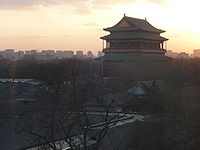- Gulou and Zhonglou (Beijing)
-
Performance at the Drum Tower

Gǔlóu (鼓楼), the drum tower of Beijing, is situated at the northern end of the central axis of the Inner City to the north of Di’ anmen Street. Originally built for musical reasons, it was later used to announce the time and is now a tourist attraction.
Zhōnglóu (钟楼), the bell tower of Beijing, stands closely behind the drum tower. Together with the drum tower, they provide an overview of central Beijing and before the modern era, they both dominated Beijing's ancient skyline.
Contents
Function
Bells and drums were musical instruments in ancient China. Later they were used by government and common people as timepieces. The Bell and Drum towers were the center of Chinese chronology during the Yuan, Ming and Qing dynasties.
The Bell and Drum Towers continued to function as the official timepiece of China and government until 1924, when the last emperor of the Qing Dynasty was forced to leave the Forbidden City) and western-style clockwork was made the official means of time-keeping.
History
The Drum Tower was built in 1272 during the reign of Kublai Khan, at which time it stood at the very heart of the Yuan capital Dadu. At that time it was known as the Tower of Orderly Administration (Qizhenglou). In 1420, under the Ming Emperor Yongle, the building was reconstructed to the east of the original site and in 1800 under the Qing Emperor Jiaqing, large-scale renovations were carried out. In 1924, Feng Yuxiang removed the official status of the towers, replacing them with western time-keeping methods, and renamed the building "Mingchilou". Objects related to the Eight-Power Allied Forces’ invasion of Beijing and later the May 30 Massacre of 1925 were put on display, turning the towers as a museum. Nowadays, the upper story of the building serves as the People’s Cultural Hall of the East City District.
In the 1980s, after much repair, the Bell and Drum Towers were opened to tourists.
Architecture
The Drum tower is a two-story building made of wood with a height of 47 meters. In ancient times the upper story of the building housed 24 drums, of which only one survives. Nearby stands the Bell Tower, a 33-meter-high edifice with gray walls and a green glazed roof.
Gallery
Drum Tower
Bell Tower
See also
- 2008 Beijing Drum Tower stabbings
External links
- The Drum Tower 360-degree Virtual Tour and Photographs
- The Drum and Bell Towers in Beijing 30 High Quality Photographs
Coordinates: 39°56′24.68″N 116°23′22.69″E / 39.9401889°N 116.3896361°E
Old city of Beijing Subdivisions 
Fortifications and towers Yongdingmen Gate • Zhengyangmen Gate • Zhonghuamen • Tiananmen Gate • Deshengmen Gate • Bell and Drum towersForbidden City Temples and gardens Beihai Park • Shichahai • Zhongnanhai • Jingshan Park • Zhongshan Park • Fragrant Hills • Temple of Heaven • Temple of Earth • Temple of the Sun • Temple of the Moon • Confucius Temple • Taimiao (Imperial Ancestral Temple) • Xiannongtan (Temple of Agriculture) • Yonghe Temple • Fayuan Temple • White Cloud Temple • Zhen Jue Temple • Miaoying Temple • Wanshou Temple • Temple of Azure Clouds • Badachu • Dongyue Temple • Guanghua Temple • Tanzhe Temple • Wofo Temple • Big Bell Temple • Bailin Temple • Guangji Temple • Fahai Temple • Changchun Temple • Zhihua Temple • Yunju TempleCategories:- Buildings and structures in Beijing
- Visitor attractions in Beijing
Wikimedia Foundation. 2010.










